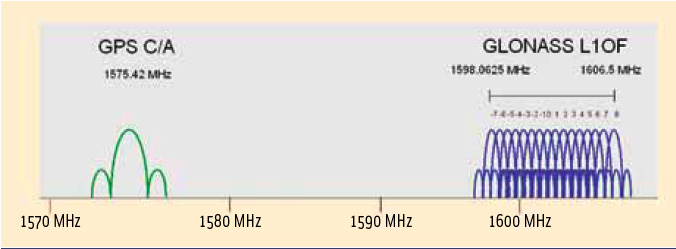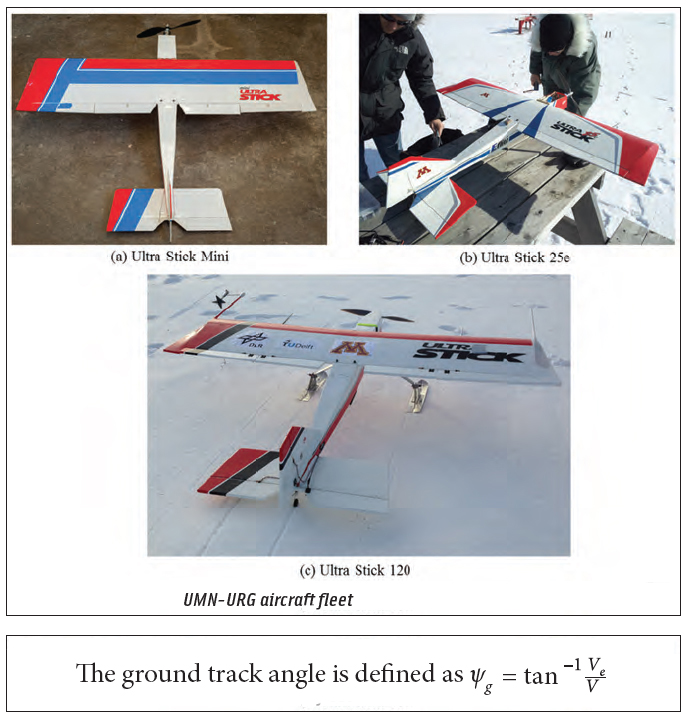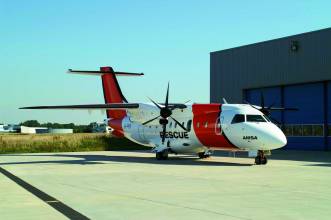 FIGURE 1: GPS/GLONASS L1 frequency band
FIGURE 1: GPS/GLONASS L1 frequency bandAs is well known, Galileo will become the European complement to the U.S. Global Positioning system.
But what about Russia’s GLONASS?
Although this constellation has been in operation for nearly three decades, the limited number of available satellites along with an uncertain governmental commitment to GLONASS performance until recent years had seriously restricted its use for aviation.
As is well known, Galileo will become the European complement to the U.S. Global Positioning system.
But what about Russia’s GLONASS?
Although this constellation has been in operation for nearly three decades, the limited number of available satellites along with an uncertain governmental commitment to GLONASS performance until recent years had seriously restricted its use for aviation.
However, the ongoing and planned modernization of the GLONASS space and ground segments, as well as an increasing number of satellites in orbit, will lead in the mid-term to an attractive additional constellation for airborne receivers.
Moreover, international regulatory agreements already allow the use of GLONASS L1 receivers onboard civil aircraft. Standards and recommended practices (SARPS) for GLONASS L1 receivers have been published for several years by ICAO (International Civil Aviation Organization). In addition, a recent Russian regulation mandates the integration of a GLONASS receiver onboard Russian-manufactured aircraft.
So, why don’t we take a fresh look at this GNSS system and assess its potential benefit for aviation? This article will examine the utility of the GLONASS, particularly its new signal plan initiated with the K-generation of satellites, in the context of a multi-constellation receiver development project.
Using Multiple GNSSes
Multi-constellation receivers are considered by all aviation actors as the future of airborne navigation. Taking advantage of an increased number of satellites and multi-frequency capability, such receivers will benefit simultaneously from an improved satellite signal availability and better positioning, velocity, and timing (PVT) accuracy.
A lot has been done regarding combined GPS/Galileo aviation equipment. Standards have been discussed for years and are currently developed in the leadership of working groups of the European Organization for Civil Aviation Equipment (EUROCAE) and RTCA Inc. (formerly Radio Technical Commission for Aeronautics).
However, until now, standards have not been achieved to support Galileo/ GLONASS capability for civil airborne receivers, mainly due to the fact that no obvious signal compatibility and spectrum commonality exists at the receiver level. The frequencies and types of modulations of the two GNSS systems are indeed different and require two separate RF chains for L1 to comply with interference rejection–mask requirements (see Figure 1, above right).
However, the recently introduced GLONASS-K modulation scheme creates new opportunities for synergy between Galileo and GLONASS.
GLONASS Constellation Roadmap and GLONASS-K
The current GLONASS constellation comprises 22 operational GLONASS-M satellites and one experimental GLONASS-K satellite. As shown in the GLONASS roadmap proposed by Russian authorities, several additional civil signals should be broadcast by next-generation satellites on L1 (1575.42 MHz), L3 (1202.025 MHz), and L5 (1176.45 MHz) frequencies.
The first experimental GLONASS-K satellite actually launched on February 26, 2011, will broadcast a new type of civil signal on L3. Although an official GLONASS-K interface control document (ICD) is not expected to be available before end of this year, some L3 signal characteristics have been made public.
. . .
Interference Rejection Masks
The main challenge in the receiver mockup RF design is linked to the compliance with standardized rejection masks. The GPS L1 and GLONASS L1 figures for these masks were standardized a long time ago and are well known to aviation manufacturers. They are provided in the ICAO SARPS Annex 10.
. . .
Standards for Civil Aviation
The development of an airborne receiver for civil aviation is ruled by compliance to specific standards. To be used onboard an aircraft, a GNSS receiver must obtain a TSO (technical standard order) from the U.S. Federal Aviation Administration or the European Aviation Safety Agency. This TSO guarantees that the receiver can achieve performance levels as defined in documents called minimum operational performance specifications (MOPS), complies with specific hardware and software development assurance levels, and withstands aeronautical-grade temperature, vibrations, and humidity conditions.
The MOPS document provides very detailed and stringent requirements describing receiver development, performance, test procedures, and internal algorithms. MOPS are discussed and elaborated by RTCA and EUROCAE technical working groups.
. . .
Pulse Mitigation Technique
One of the issues linked to the use of aeronautical E5/L3 band is the overlapping presence of ground and on-board emitters dedicated to distance measuring equipment (DME) used for aircraft positioning. The power of these emissions can reach significant values at the antenna port and, as a result, may considerably degrade the signal-tracking performance of GNSS receivers.
. . .
Receiver Mock-Up
The GAGARIN program developed a mock-up of a multi-constellation receiver, that is fully representative of a future airborne multi-constellation receiver with a form and fit factor that complies with the ARINC Characteristic 743 specifications for an airborne GPS receiver. The hardware and the PVT software have been developed by NAVIS while the signal-processing was designed by Thales.
. . .
Conclusions
In the frame of the GAGARIN study, we have demonstrated the feasibility of a GPS/Galileo/GLONASS-K triple-constellation receiver for civil airborne applications. Compliance with the draft Galileo MOPS and the GPS standards has been assessed, and the interest of Galileo/GLONASS-K combination has been evaluated.
The receiver mock-up embeds state-of-the-art technology at the RF and signal-processing level and provides a triple-constellation capability. At the same time, a GLONASS-K constellation simulator was developed, paving the way to future multi-constellation receiver development.
For the complete story, including figures, graphs, and images, please download the PDF of the article, above.
Acknowledgments
The author acknowledges all the GAGARIN team that took parts in the mockup development and study, as well the European Commission members who supported this project. He also acknowledges Vladimir Korchagin for the consultancy during the work and paper review as well as the Thales people involved in this article review. The research leading to these results has received funding from the European Community’s Seventh Framework Program (FP7/2007-2013) under grant agreement Number 226454.



